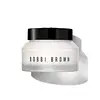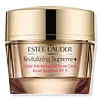What's inside
What's inside
 Key Ingredients
Key Ingredients

 Benefits
Benefits

 Concerns
Concerns

 Ingredients Side-by-side
Ingredients Side-by-side

Water
Skin ConditioningGlycerin
HumectantButyrospermum Parkii Butter
Skin ConditioningCaprylic/Capric/Myristic/Stearic Triglyceride
EmollientButylene Glycol
HumectantNeopentyl Glycol Diheptanoate
EmollientAlgae Extract
EmollientTocopheryl Acetate
AntioxidantSodium Hyaluronate
HumectantHelianthus Annuus Seedcake
AbrasiveGlycine Soja Seed Extract
Skin ConditioningCitrullus Lanatus Fruit Extract
Skin ConditioningSalvia Sclarea Extract
AntiseborrhoeicLens Esculenta Fruit Extract
Skin ConditioningPyrus Malus Fruit Extract
Skin ConditioningHordeum Vulgare Extract
EmollientCamellia Japonica Flower Extract
EmollientLactobacillus Ferment
Skin ConditioningPropylene Glycol Dicaprate
EmollientPolyacrylate Crosspolymer-6
Emulsion StabilisingSorbitol
HumectantSodium Polyaspartate
HumectantLecithin
EmollientTrehalose
HumectantCoco-Caprylate/Caprate
EmollientRosmarinus Officinalis Leaf Water
MaskingSodium Lactate
BufferingCucumis Sativus Fruit Extract
EmollientT-Butyl Alcohol
PerfumingSodium PCA
HumectantHydroxyethyl Urea
HumectantC9-12 Alkane
SolventSodium Acrylates Copolymer
Propanediol
SolventCitric Acid
BufferingDisodium EDTA
Potassium Sorbate
PreservativeSodium Benzoate
MaskingChlorphenesin
AntimicrobialPhenoxyethanol
PreservativeWater, Glycerin, Butyrospermum Parkii Butter, Caprylic/Capric/Myristic/Stearic Triglyceride, Butylene Glycol, Neopentyl Glycol Diheptanoate, Algae Extract, Tocopheryl Acetate, Sodium Hyaluronate, Helianthus Annuus Seedcake, Glycine Soja Seed Extract, Citrullus Lanatus Fruit Extract, Salvia Sclarea Extract, Lens Esculenta Fruit Extract, Pyrus Malus Fruit Extract, Hordeum Vulgare Extract, Camellia Japonica Flower Extract, Lactobacillus Ferment, Propylene Glycol Dicaprate, Polyacrylate Crosspolymer-6, Sorbitol, Sodium Polyaspartate, Lecithin, Trehalose, Coco-Caprylate/Caprate, Rosmarinus Officinalis Leaf Water, Sodium Lactate, Cucumis Sativus Fruit Extract, T-Butyl Alcohol, Sodium PCA, Hydroxyethyl Urea, C9-12 Alkane, Sodium Acrylates Copolymer, Propanediol, Citric Acid, Disodium EDTA, Potassium Sorbate, Sodium Benzoate, Chlorphenesin, Phenoxyethanol
Water
Skin ConditioningOctocrylene
UV AbsorberButyloctyl Salicylate
Skin ConditioningEthylhexyl Salicylate
UV AbsorberGlycerin
HumectantButyl Methoxydibenzoylmethane
UV AbsorberPolysorbate 60
EmulsifyingCetyl Alcohol
EmollientSorbitan Stearate
EmulsifyingDimethicone
EmollientTridecyl Stearate
EmollientButylene Glycol
HumectantPentylene Glycol
Skin ConditioningMoringa Oleifera Seed Extract
Skin ConditioningTuna Extract
Skin ConditioningHordeum Vulgare Extract
EmollientCucumis Sativus Fruit Extract
EmollientNarcissus Tazetta Bulb Extract
AstringentSigesbeckia Orientalis Extract
Skin ConditioningPyrus Malus Fruit Extract
Skin ConditioningLens Esculenta Fruit Extract
Skin ConditioningLactis Proteinum
Skin ConditioningCitrus Medica Vulgaris Fruit Extract
AntioxidantCaffeine
Skin ConditioningAlgae Extract
EmollientLaminaria Digitata Extract
Skin ProtectingTocopheryl Acetate
AntioxidantAcetyl Glucosamine
Skin ConditioningAstrocaryum Murumuru Seed Butter
EmollientSucrose
HumectantTridecyl Trimellitate
EmollientDipentaerythrityl Hexacaprylate/Hexacaprate
EmulsifyingPEG-100 Stearate
Trehalose
HumectantCetyl Palmitate
EmollientSorbitol
HumectantAcetyl Hexapeptide-8
HumectantSodium Lactate
BufferingAcrylates/C10-30 Alkyl Acrylate Crosspolymer
Emulsion StabilisingSodium Benzoate
MaskingSorbitan Palmitate
EmulsifyingSorbitan Olivate
EmulsifyingEthylhexylglycerin
Skin ConditioningSodium PCA
HumectantPvp
Emulsion StabilisingSodium Polyacrylate
AbsorbentPropylene Glycol Dicaprate
EmollientSodium Hyaluronate
HumectantIsoceteth-20
EmulsifyingHelianthus Annuus Seedcake
AbrasivePolyethylene
AbrasiveParfum
MaskingTetrahexyldecyl Ascorbate
AntioxidantSodium Hydroxide
BufferingDisodium EDTA
BHT
AntioxidantPhenoxyethanol
PreservativeChlorphenesin
AntimicrobialCI 19140
Cosmetic ColorantCI 14700
Cosmetic ColorantWater, Octocrylene, Butyloctyl Salicylate, Ethylhexyl Salicylate, Glycerin, Butyl Methoxydibenzoylmethane, Polysorbate 60, Cetyl Alcohol, Sorbitan Stearate, Dimethicone, Tridecyl Stearate, Butylene Glycol, Pentylene Glycol, Moringa Oleifera Seed Extract, Tuna Extract, Hordeum Vulgare Extract, Cucumis Sativus Fruit Extract, Narcissus Tazetta Bulb Extract, Sigesbeckia Orientalis Extract, Pyrus Malus Fruit Extract, Lens Esculenta Fruit Extract, Lactis Proteinum, Citrus Medica Vulgaris Fruit Extract, Caffeine, Algae Extract, Laminaria Digitata Extract, Tocopheryl Acetate, Acetyl Glucosamine, Astrocaryum Murumuru Seed Butter, Sucrose, Tridecyl Trimellitate, Dipentaerythrityl Hexacaprylate/Hexacaprate, PEG-100 Stearate, Trehalose, Cetyl Palmitate, Sorbitol, Acetyl Hexapeptide-8, Sodium Lactate, Acrylates/C10-30 Alkyl Acrylate Crosspolymer, Sodium Benzoate, Sorbitan Palmitate, Sorbitan Olivate, Ethylhexylglycerin, Sodium PCA, Pvp, Sodium Polyacrylate, Propylene Glycol Dicaprate, Sodium Hyaluronate, Isoceteth-20, Helianthus Annuus Seedcake, Polyethylene, Parfum, Tetrahexyldecyl Ascorbate, Sodium Hydroxide, Disodium EDTA, BHT, Phenoxyethanol, Chlorphenesin, CI 19140, CI 14700
Ingredients Explained
These ingredients are found in both products.
Ingredients higher up in an ingredient list are typically present in a larger amount.
Algae Extract is a confusing name. This is because algae is an informal term for a group of 30,000 aquatic organisms that can photosynthesize.
The term 'algae extract' can refer to any one, or a blend of, the 30,000 types.
Algae is rich in antioxidants. Antioxidants help fight free-radicals. Free-radicals are molecules that may damage your skin cells, such as pollution.
Algae can also help with soothing and hydrating skin.
Many different types of algae have different benefits.
Learn more about Algae ExtractButylene Glycol (or BG) is used within cosmetic products for a few different reasons:
Overall, Butylene Glycol is a safe and well-rounded ingredient that works well with other ingredients.
Though this ingredient works well with most skin types, some people with sensitive skin may experience a reaction such as allergic rashes, closed comedones, or itchiness.
Learn more about Butylene GlycolChlorphenesin is a synthetic preservative. It helps protect a product against bacteria in order to extend shelf life. In most cases, Chlorphenesin is paired with other preservatives such as phenoxyethanol and caprylyl glycol.
Chlorphenesin is a biocide. This means it is able to help fight the microorganisms on our skin. It is also able to fight odor-releasing bacteria.
Chlorphenesin is soluble in both water and glycerin.
Studies show Chlorphenesin is easily absorbed by our skin. You should speak with a skincare professional if you have concerns about using Chlorphenesin.
Learn more about ChlorphenesinThis extract comes from cucumber. Cucumbers are mostly made up of water (95%), and the other 5% is composed of: vitamin C, caffeic acid, fatty acids, amino acids, and other minerals.
Cucumbers have anti-inflammatory, barrier repair, and hydrating properties.
They contain shikimate dehydrigenase, an enzyme shown to help reduce inflammation and soothe the skin.
The amino acids found in cucumbers help nourish our skin's natural acid mantle (it's an important part of our skin barrier). This slightly acidic film acts as a barrier to protect us from bacteria, viruses, and other contaminants.
Unless you have an allergy to cucumbers, this is generally a non-irritating ingredient.
Fun fact: Cucumis Sativus is native to South Asia and can now be found on every continent.
Learn more about Cucumis Sativus Fruit ExtractDisodium EDTA plays a role in making products more stable by aiding other preservatives.
It is a chelating agent, meaning it neutralizes metal ions that may be found in a product.
Disodium EDTA is a salt of edetic acid and is found to be safe in cosmetic ingredients.
Learn more about Disodium EDTAGlycerin is already naturally found in your skin. It helps moisturize and protect your skin.
A study from 2016 found glycerin to be more effective as a humectant than AHAs and hyaluronic acid.
As a humectant, it helps the skin stay hydrated by pulling moisture to your skin. The low molecular weight of glycerin allows it to pull moisture into the deeper layers of your skin.
Hydrated skin improves your skin barrier; Your skin barrier helps protect against irritants and bacteria.
Glycerin has also been found to have antimicrobial and antiviral properties. Due to these properties, glycerin is often used in wound and burn treatments.
In cosmetics, glycerin is usually derived from plants such as soybean or palm. However, it can also be sourced from animals, such as tallow or animal fat.
This ingredient is organic, colorless, odorless, and non-toxic.
Glycerin is the name for this ingredient in American English. British English uses Glycerol/Glycerine.
Learn more about GlycerinHelianthus Annuus Seedcake is an exfoliant and isn't fungal acne safe.
We don't have a description for Hordeum Vulgare Extract yet.
We don't have a description for Lens Esculenta Fruit Extract yet.
Phenoxyethanol is a preservative that has germicide, antimicrobial, and aromatic properties. Studies show that phenoxyethanol can prevent microbial growth. By itself, it has a scent that is similar to that of a rose.
It's often used in formulations along with Caprylyl Glycol to preserve the shelf life of products.
Propylene Glycol Dicaprate is an emollient and emulsifier. It is created from a mixture of fatty acids.
Pyrus Malus Fruit Extract is extract from Apples. Apples are rich in Vitamin C, sugars, and antioxidants.
The sugar in Apples are humectants and help hydrate the skin. On top of that, apples also contain some acids, such as malic acid. These acids may have a mild exfoliating effect.
Last, the phytochemicals found in apples are strong antioxidants. These antioxidants help with anti-aging as they protect your skin cells against oxidative damage.
Learn more about Pyrus Malus Fruit ExtractSodium Benzoate is a preservative. It's used in both cosmetic and food products to inhibit the growth of mold and bacteria. It is typically produced synthetically.
Both the US FDA and EU Health Committee have approved the use of sodium benzoate. In the US, levels of 0.1% (of the total product) are allowed.
Sodium benzoate works as a preservative by inhibiting the growth of bacteria inside of cells. It prevents the cell from fermenting a type of sugar using an enzyme called phosphofructokinase.
It is the salt of benzoic acid. Foods containing sodium benzoate include soda, salad dressings, condiments, fruit juices, wines, and snack foods.
Studies for using ascorbic acid and sodium benzoate in cosmetics are lacking, especially in skincare routines with multiple steps.
We always recommend speaking with a professional, such as a dermatologist, if you have any concerns.
Learn more about Sodium BenzoateSodium Hyaluronate is hyaluronic acid's salt form. It is commonly derived from the sodium salt of hyaluronic acid.
Like hyaluronic acid, it is great at holding water and acts as a humectant. This makes it a great skin hydrating ingredient.
Sodium Hyaluronate is naturally occurring in our bodies and is mostly found in eye fluid and joints.
These are some other common types of Hyaluronic Acid:
Learn more about Sodium HyaluronateSodium Lactate is the sodium salt of lactic acid, an AHA. It is a humectant and sometimes used to adjust the pH of a product.
This ingredient is part of our skin's NMF, or natural moisturizing factor. Our NMF is essential for the hydration of our top skin layers and plasticity of skin. NMF also influences our skin's natural acid mantle and pH, which protects our skin from harmful bacteria.
High percentages of Sodium Lactate can have an exfoliating effect.
Fun fact: Sodium Lactate is produced from fermented sugar.
Learn more about Sodium LactateSodium PCA is the sodium salt of pyroglutamic acid. It is naturally occurring in our skin's natural moisturizing factors where it works to maintain hydration.
The PCA stands for pyrrolidone carboxylic acid, a natural amino acid derivative.
This ingredient has skin conditioning, anti-inflammatory, and humectant properties. Humectants help hydrate your skin by drawing moisture from the air. This helps keep your skin moisturized.
Learn more about Sodium PCASorbitol is a sugar alcohol. It is a hydrating and moisturizing agent created from the reduction process of glucose.
Most sorbitol is usually made from potato starch. It is also found in fruits such as apples and pears.
As a humectant, Sorbitol helps draw water to the skin. This helps keep the skin hydrated. Sorbitol also helps create a thicker texture in products. You might find sorbitol in your toothpaste and other gels.
It is a non-irritating ingredient that is great for those with dry skin.
Sorbitol is a prebiotic. It helps promote the growth of healthy bacteria on your skin. The bacteria on your skin form a microbiome. This microbiome helps protect your skin from infection and harmful bacteria.
Learn more about SorbitolTocopheryl Acetate is AKA Vitamin E. It is an antioxidant and protects your skin from free radicals. Free radicals damage the skin by breaking down collagen.
One study found using Tocopheryl Acetate with Vitamin C decreased the number of sunburned cells.
Tocopheryl Acetate is commonly found in both skincare and dietary supplements.
Learn more about Tocopheryl AcetateTrehalose is a disaccharide made of two glucose molecules (glucose is sugar!). Trehalose is used to help moisturize skin. It also has antioxidant properties.
As a humectant, trehalose helps draw moisture from the air to your skin. This helps keep your skin hydrated.
Due to its antioxidant properties, trehalose may help with signs of aging. Antioxidants help fight free-radical molecules, unstable molecules that may damage your skin.
In medicine, trehalose and hyaluronic acid are used to help treat dry eyes.
Some animals, plants, and bacteria create trehalose as a source of energy to survive freeze or lack of water.
Learn more about TrehaloseWater. It's the most common cosmetic ingredient of all. You'll usually see it at the top of ingredient lists, meaning that it makes up the largest part of the product.
So why is it so popular? Water most often acts as a solvent - this means that it helps dissolve other ingredients into the formulation.
You'll also recognize water as that liquid we all need to stay alive. If you see this, drink a glass of water. Stay hydrated!
Learn more about Water